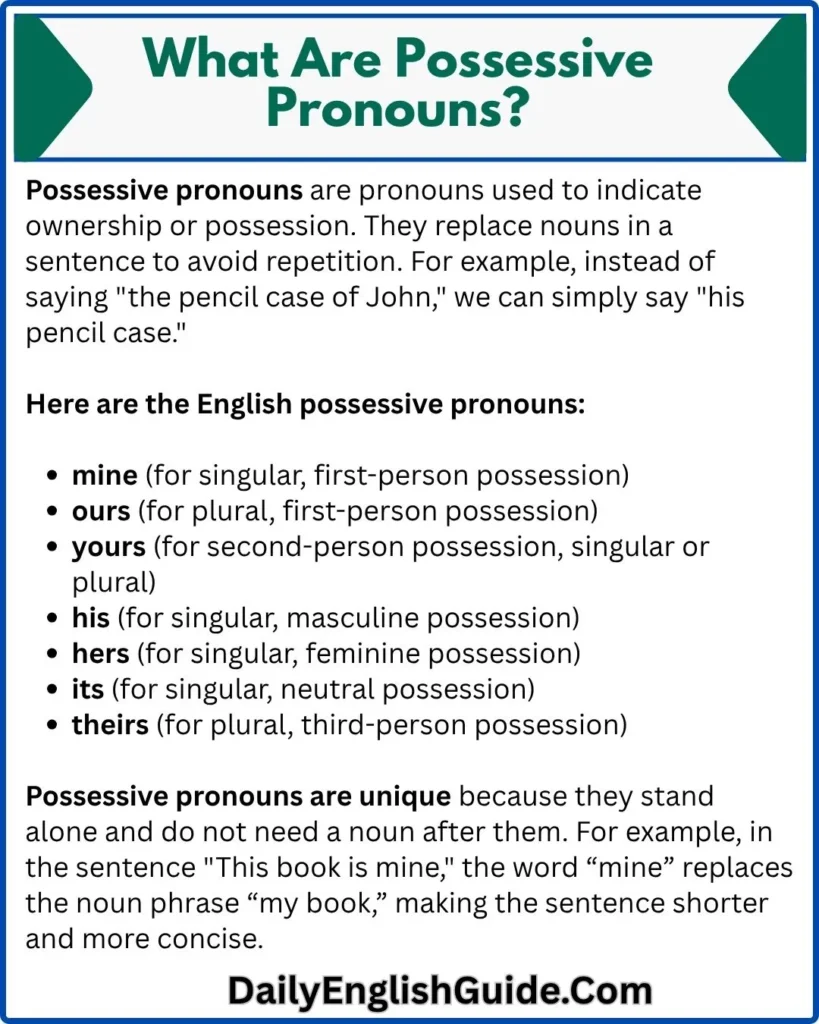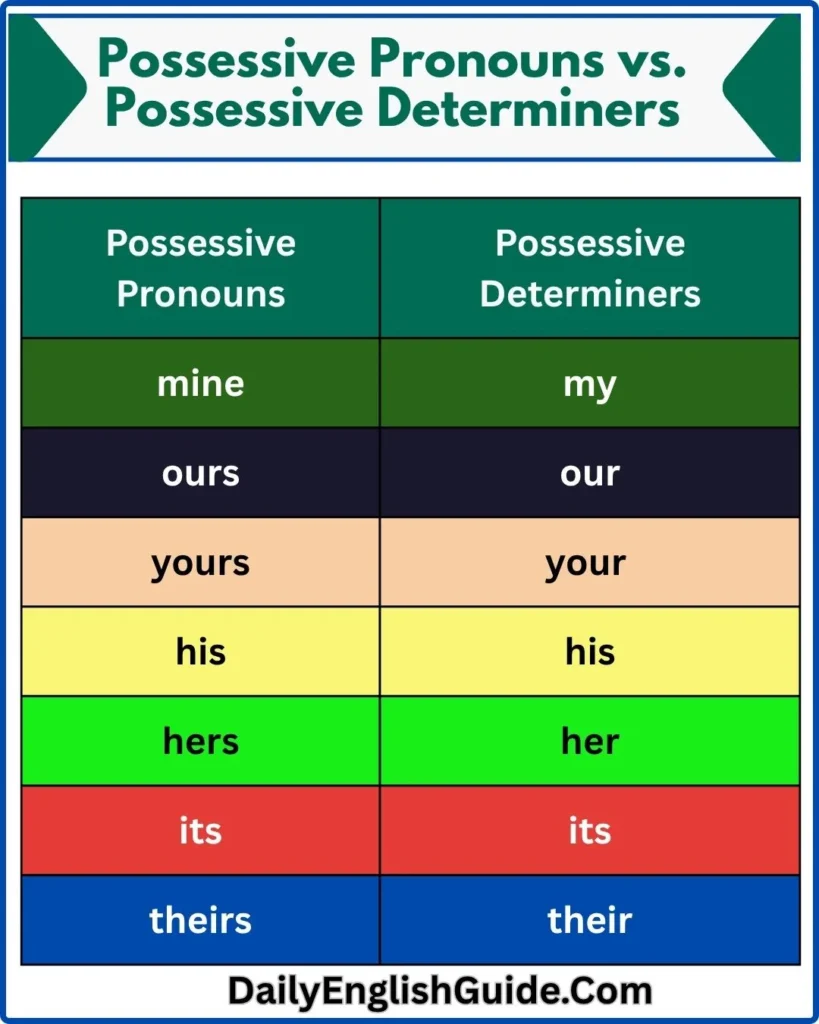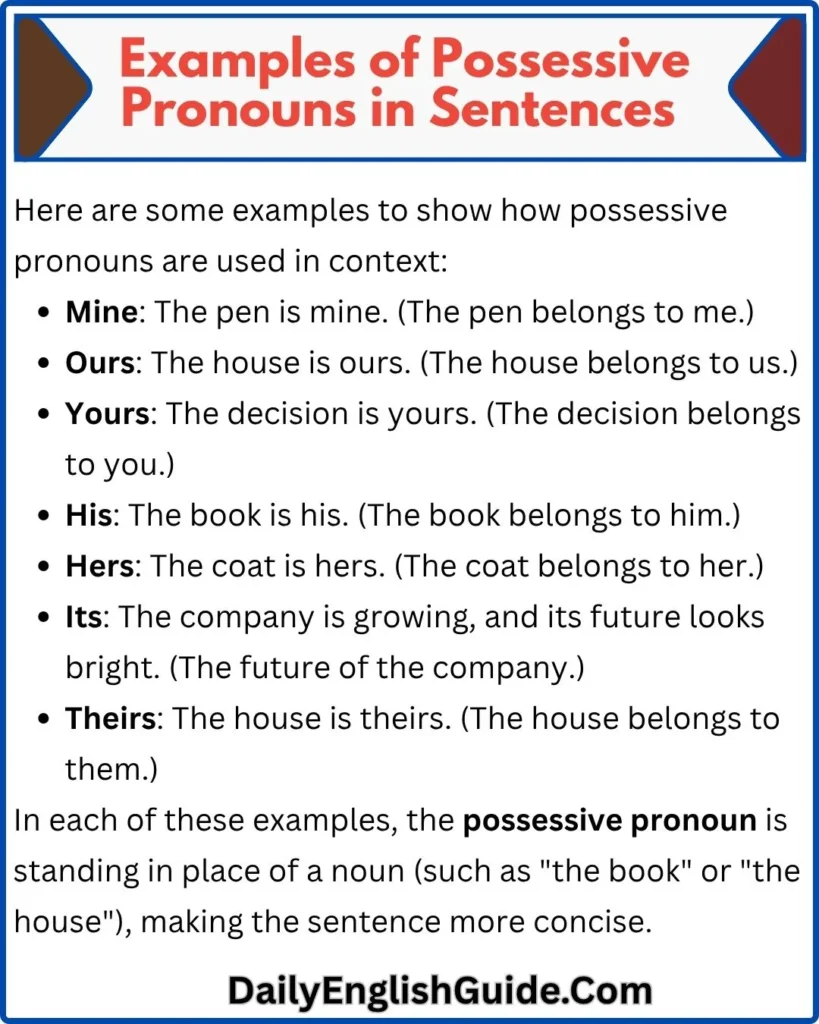Possessive pronouns are a fundamental aspect of English grammar, but their usage and distinction from other pronouns and determiners can sometimes be confusing. In this article, we will explore the role of possessive pronouns, their differences from possessive determiners, common mistakes, and more. Let’s dive in and make these concepts clearer.

What Are Possessive Pronouns?
Possessive pronouns are pronouns used to indicate ownership or possession. They replace nouns in a sentence to avoid repetition. For example, instead of saying “the pencil case of John,” we can simply say “his pencil case.”
Here are the English possessive pronouns:
-
mine (for singular, first-person possession)
-
ours (for plural, first-person possession)
-
yours (for second-person possession, singular or plural)
-
his (for singular, masculine possession)
-
hers (for singular, feminine possession)
-
its (for singular, neutral possession)
-
theirs (for plural, third-person possession)
Possessive pronouns are unique because they stand alone and do not need a noun after them. For example, in the sentence “This book is mine,” the word “mine” replaces the noun phrase “my book,” making the sentence shorter and more concise.
Possessive Pronouns vs. Possessive Determiners
One common area of confusion for many learners is the difference between possessive pronouns and possessive determiners. While these two share similarities, they have distinct roles in sentences.
Possessive pronouns stand alone and replace a noun in a sentence:
-
Example: The book is mine.
Possessive determiners (also known as possessive adjectives) always appear before a noun and modify that noun:
-
Example: This is my book.
Here is a table to clarify the difference:
| Possessive Pronouns | Possessive Determiners |
|---|---|
| mine | my |
| ours | our |
| yours | your |
| his | his |
| hers | her |
| its | its |
| theirs | their |
Key Point: The primary difference is that possessive pronouns replace nouns, while possessive determiners modify nouns.

How to Use Possessive Pronouns in Sentences?
Possessive pronouns are used to replace nouns and indicate ownership or possession. These pronouns provide a more efficient way of making statements without unnecessary repetition. Let’s consider the following examples:
-
Repetition without possessive pronouns:
-
“This is John’s pen, and the pen is John’s.”
-
-
Using possessive pronouns:
-
“This is John’s pen, and the pen is his.”
-
As you can see, possessive pronouns not only replace the noun but also eliminate the need for repetition. They help to make sentences more fluid and concise.
Possessive pronouns can also indicate more abstract forms of possession, such as relationships or personal associations, rather than just physical objects. For instance:
-
“This is my friend, Sarah.”
-
“This home is theirs, and they cherish it deeply.”
Examples of Possessive Pronouns in Sentences
Here are some examples to show how possessive pronouns are used in context:
-
Mine: The pen is mine. (The pen belongs to me.)
-
Ours: The house is ours. (The house belongs to us.)
-
Yours: The decision is yours. (The decision belongs to you.)
-
His: The book is his. (The book belongs to him.)
-
Hers: The coat is hers. (The coat belongs to her.)
-
Its: The company is growing, and its future looks bright. (The future of the company.)
-
Theirs: The house is theirs. (The house belongs to them.)
In each of these examples, the possessive pronoun is standing in place of a noun (such as “the book” or “the house”), making the sentence more concise.

Agreement with the Antecedent
A crucial concept when using possessive pronouns is ensuring agreement with the antecedent. The antecedent is the noun (or noun phrase) that the possessive pronoun refers to. In other words, the possessive pronoun must align with the noun it’s replacing in terms of person, gender, and number.
For example:
-
Example 1: “The book is hers.” (The antecedent, “book,” is singular and feminine, so the pronoun “hers” agrees with it.)
-
Example 2: “The toys are theirs.” (The antecedent, “toys,” is plural, so the pronoun “theirs” is used.)
In English, possessive pronouns must match the following characteristics of their antecedents:
-
Person: Whether the speaker is referring to themselves, someone else, or a group.
-
Gender: Whether the noun being replaced is masculine, feminine, or neutral.
-
Number: Whether the noun being replaced is singular or plural.
Examples of Agreement with the Antecedent:
-
Singular, masculine: “The hat is his.”
-
Singular, feminine: “The dress is hers.”
-
Plural, neutral: “The books are theirs.”
-
Plural, first-person: “The toys are ours.”
Subject-Verb Agreement with Possessive Pronouns
An interesting aspect of possessive pronouns is their interaction with subject-verb agreement. When possessive pronouns serve as the subject of a sentence, the verb form will depend on the noun the pronoun refers to, not the pronoun itself. This is important because the thing being possessed can be singular or plural, and the subject-verb agreement will follow that.
For example:
-
Singular possession: “Her favorite color is purple.”
-
The verb “is” is singular because “color” is singular.
-
-
Plural possession: “Mine are green.”
-
Here, the verb “are” is plural because “mine” refers to multiple items.
-
It’s essential to remember that the subject determines the verb form, not the possessive pronoun itself.
Examples:
-
Her favorite color is purple, but mine is green.
-
I know you’re a bit scared of dogs, but I promise mine are really friendly.
Common Mistakes with Possessive Pronouns
Even though possessive pronouns help us avoid repetitive sentences, they often lead to common mistakes, especially with apostrophes and similar-sounding words. Let’s address a few of these mistakes:
1. Its vs. It’s
One of the most common confusions in English grammar involves the difference between its and it’s.
-
Its is the possessive form of “it,” indicating ownership (e.g., “The dog chased its tail.”).
-
It’s is a contraction for “it is” or “it has” (e.g., “It’s raining outside.”).
Common mistake:
-
Incorrect: “The dog wagged it’s tail.”
-
Correct: “The dog wagged its tail.”
Tip: When you are unsure whether to use its or it’s, check if you can replace it with “it is” or “it has.” If you can, use it’s; if not, its is correct.
2. Who’s vs. Whose
Another common mistake comes with who’s and whose.
-
Who’s is a contraction for “who is” or “who has” (e.g., “Who’s coming to the party?”).
-
Whose is a possessive pronoun used to indicate ownership (e.g., “Whose book is this?”).
Common mistake:
-
Incorrect: “Who’s pen is this?”
-
Correct: “Whose pen is this?”
Again, the apostrophe indicates a contraction, so be sure to differentiate it from the possessive form whose.
3. Incorrect Possessive Forms
It’s crucial to remember that possessive pronouns do not take apostrophes. Incorrect forms like your’s, their’s, our’s, or her’s are grammatically incorrect.
-
Incorrect: “This book is your’s.”
-
Correct: “This book is yours.”
Always avoid adding apostrophes to possessive pronouns.
The Role of “Whose”
The word whose stands out because it functions differently from the other possessive pronouns. It is not a personal possessive pronoun but rather an interrogative pronoun or relative pronoun.
-
Interrogative pronoun: “Whose pen is this?” (asking a question about ownership)
-
Relative pronoun: “The man whose dog was lost is here.” (providing more information about the noun “man”)
Unlike other possessive pronouns, whose can also function as a possessive determiner in relative clauses:
-
Example: “The person whose book you borrowed is waiting outside.”
Using Possessive Pronouns in Different Contexts
Possessive pronouns are not limited to physical objects; they can also indicate more abstract forms of ownership or association. Understanding the wide range of scenarios in which possessive pronouns can be used will help clarify their function and versatility in language.
Possessive Pronouns in Relationships
In addition to referring to tangible possessions, possessive pronouns can express personal relationships or connections. This usage is common in both casual and formal contexts, and the pronoun serves to establish ownership of a relationship rather than a physical item.
Examples:
-
“This is my friend, Sarah.”
-
“Will you marry me and be yours forever?”
-
“She really missed her hometown.”
In these cases, the possessive pronouns do not refer to physical possessions but to an emotional or relational connection.
Possessive Pronouns in Emotional or Psychological Contexts
Possessive pronouns can also indicate emotional or psychological attachment to something. For example, saying “this book is mine” can imply not just ownership but also a deeper emotional connection to the item. In this sense, possessive pronouns are versatile and can express more than mere physical possession.
Examples:
-
“The letter is mine” could indicate a personal or sentimental connection.
-
“This place is ours” might reflect a sense of belonging or emotional attachment.
Special Cases and Common Misunderstandings
While possessive pronouns are simple in concept, there are a few special cases and nuances that learners of English often struggle with. We’ll explore some of these here:
1. Its vs. His/Hers
The possessive pronoun its is often misunderstood because it seems to deviate from the pattern seen with other possessive pronouns like his or hers. Some learners mistakenly think that its should have an apostrophe, but remember, its is already the possessive form (just like his or hers).
Correct: “The cat chased its tail.”
Incorrect: “The cat chased it’s tail.”
2. Singular Possessions in Plural Contexts
Possessive pronouns can also be used in contexts where the object of possession is singular but the subject is plural. For example:
-
“The car is ours” (plural subject, singular possession).
This use of possessive pronouns is more subtle but still follows the basic rule of agreement. While the possessive pronoun agrees with the owner (in this case, we), the item being owned is still singular.
3. Whose as a Possessive Pronoun
The word whose is distinct because it can serve as both an interrogative and a relative pronoun. It’s frequently used to show possession, even though it’s not typically thought of as a possessive pronoun in a traditional sense.
-
Interrogative: “Whose is this coat?”
-
Relative: “The woman whose house was built last year is moving.”
This dual role of whose can cause confusion, but remembering its function in forming questions and adding information about a noun phrase can help clear things up.
Practical Tips for Using Possessive Pronouns
To avoid mistakes and improve your use of possessive pronouns, here are some practical tips:
-
Tip 1: Be mindful of apostrophes: Never use apostrophes in possessive pronouns (e.g., your’s, her’s).
-
Tip 2: Ensure agreement: Always make sure your possessive pronoun agrees with its antecedent in person, gender, and number.
-
Tip 3: Avoid redundancy: If the context already makes the possession clear, use a possessive pronoun to avoid repeating the noun.
-
Example: “Is this your book? Yes, it is mine.”
-
Possessive Pronouns in Formal vs. Informal Contexts
Possessive pronouns are common in both informal and formal English, but their use may vary slightly based on the context. In formal writing, for instance, possessive pronouns often appear more carefully structured, while in informal conversations, they can be more flexible and colloquial.
-
Informal: “This is my place, not yours.”
-
Formal: “The rights to this document are mine.”
In both cases, the possessive pronoun serves the same basic function, but the tone and structure of the sentence may change depending on formality.
